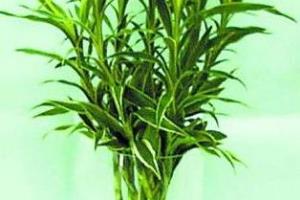Culture method of Anthurium andraeanum
Anthurium andraeanum, also known as fire crane flower, because of its broad green leaves, stamens such as Buddha flame, petals red like fire, full of auspicious and festive meaning, so deeply loved by everyone. Now let's introduce the culture method of Anthurium andraeanum.
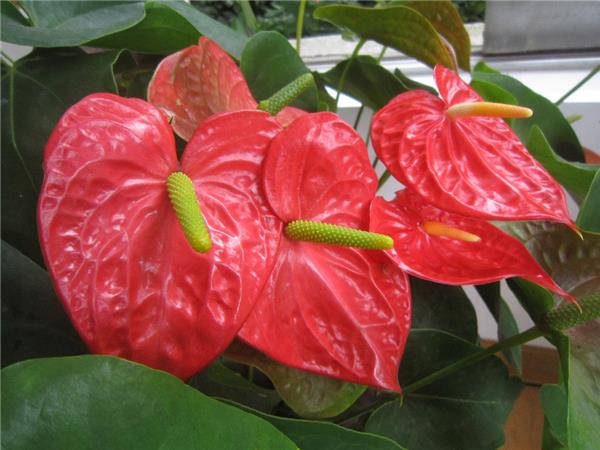
Culture methods of Anthurium andraeanum:
1. Selection of flowerpots for Anthurium andraeanum culture.
(1) flowerpot quality requirements: dark red plastic pots are often used in production. In order to coordinate with home decoration, it can be cultivated in plastic flowerpots with changing colors.
(2) the size of flowerpot: when Anthurium andraeanum plantlets or tissue culture seedlings have 2 leaves, they can be transplanted into pots with a diameter of 9 cm, and 1 plant in each pot. When the basin is full, it can be planted in a basin with a diameter of 16-20 cm.
two。 Preparation of potted soil for Anthurium andraeanum culture.
Anthurium andraeanum is rich in humus, fertile, loose and well-drained soil. Peat soil or rotten leaf soil is often used in production and perlite is added to perlite. The following formula can be used for families: peat soil: rotten leaf soil: sand: perlite = 4 / 4 / 2 / 2 / 2 / 2.
3. The watering method of Anthurium andraeanum culture.
Anthurium andraeanum likes moist soil and high air humidity. Spring, summer, autumn growth season to keep the basin soil wet, while often to its leaves and around spray, in order to increase air humidity. When the temperature dropped to about 18 ℃ at the end of autumn, the water supply was gradually reduced, which made the basin soil moist. Winter is the flowering season, can not lack of water, but because of the low temperature in winter, watering should not be more, to keep the basin soil moist, at the same time, because the indoor air humidity is low, should pay attention to its leaf and around spray several times. If arranged in an air-conditioned room, the number of sprays should be increased. Be careful not to spray water on the flowers when they bloom.
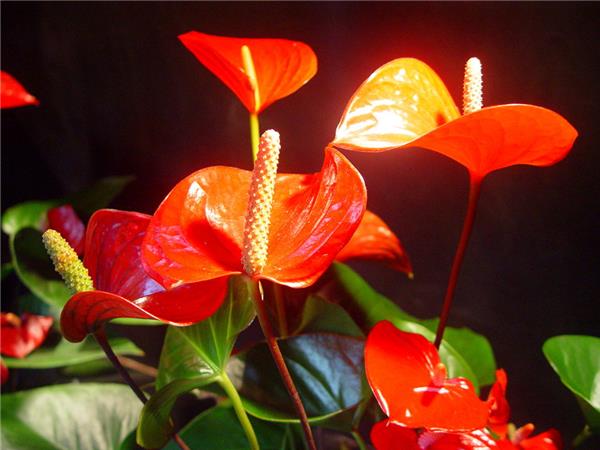
4. The fertilization method of Anthurium andraeanum culture.
Anthurium likes to be fat, but it is not resistant to thick fertilizer. No fertilizer was applied when the temperature was low in late autumn, winter and early spring, and topdressing began after new leaves grew in spring, and 10 times of rotten liquid fertilizer mixed with 1000 times of potassium dihydrogen phosphate or 1000 times of "Huaduoduo" general fertilizer was applied every 10 days. Fertilization was stopped when the temperature dropped to 15 ℃ at the end of autumn.
5. Four seasons management of Anthurium andraeanum culture.
(1) Spring management.
Change the pot when the temperature is more than 15 ℃ in spring (the young plants change the pot once a year, and the adults usually change the pot once every 2-3 years), and then move to a place suitable for light after survival.
Anthurium andraeanum is afraid of strong light and likes semi-overcast. When the temperature in early spring does not exceed 25%, it should be cultured in an environment with sufficient light. The culture should be moved to the semi-shade in the late spring. The flowering period of Anthurium andraeanum is very long, and it can blossom continuously when the conditions are right. If it is arranged in the dark place of indoor light for a long time, it will affect the subsequent flowering, and the leaves are easy to lose luster, and the petiole of new leaves is easy to elongate, resulting in lax plant shape. New leaves of Anthurium andraeanum begin to grow when the temperature is above 20 ℃ in spring. Start to fertilize after seeing the new leaves come out. The basin soil should be moist in the early stage of leaf emergence, and the amount of water should be increased after leaf emergence to keep the basin soil moist.
(2) summer management.
Anthurium andraeanum is born in the tropical rain forest with high temperature and humidity, so summer is the peak growing season of Anthurium andraeanum. Management should keep the soil moist, pay attention to replenish air humidity and apply fertilizer regularly. But Anthurium andraeanum is afraid of strong light, so it should be placed in the bright indoor light or the courtyard semi-shady place to cultivate. When it is arranged indoors, because the indoor air humidity is low, it can not meet its requirements for air humidity, so it should often spray water around it and leaves. It is best not to put Anthurium andraeanum in an air-conditioned room in summer.
(3) Autumn management.
When the temperature is high in early autumn, it is the same as that in summer. After the temperature is cool in autumn, the morning and evening light can be appropriately increased or placed in semi-shady places for culture, and other management is the same as in summer. With the decrease of air temperature, the light can be increased gradually.
When the temperature drops to 20 ℃ in autumn, Anthurium andraeanum cultivated in the courtyard should be moved to the room with light or on the windowsill in time. Pay attention to maintain the indoor temperature, and gradually reduce the number of watering to make the basin soil moist. Pay attention to replenish the indoor air humidity when decorating indoors. Stop fertilizing when the temperature drops below 18 ℃.
(4) Winter management.
Anthurium andraeanum is not cold-resistant, the indoor temperature in winter should be kept above 15 ℃, otherwise it can not blossom. If the temperature is lower than 10 ℃, Anthurium andraeanum is easy to freeze.
Sufficient light is beneficial to the flowering of Anthurium andraeanum. When there is sufficient light, Anthurium andraeanum blossoms more and the flowers are colorful. Therefore, potted plants should be placed on the windowsill with light for cultivation. However, when the light is strong, the leaf color is easy to yellowing, which is not conducive to viewing, so the strong light at noon should be covered. After flowering, the potted plants can be arranged in a brightly lit room to watch. When the indoor temperature is kept at 15 ℃ and 20 min in winter, the basin soil should be kept moist, continue to apply fertilizer, and spray several times to the leaves and surrounding of Anthurium andraeanum at noon to increase the indoor air humidity. If indoor air conditioning is used to increase temperature, the indoor air humidity will be reduced. Spray water to Anthurium andraeanum leaves and around them regularly to increase air humidity.
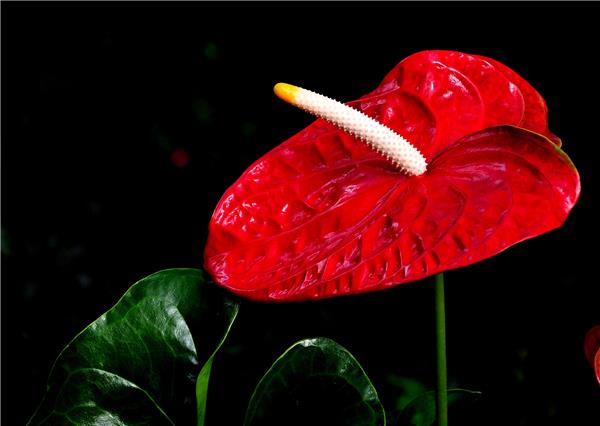
(5) florescence management.
Ensure sufficient light in the morning and evening, keep the indoor temperature above 15 ℃, wet pot soil, pay attention to fertilization to provide nutrition and ensure subsequent flowering.
6. The pruning method of Anthurium andraeanum culture.
(1) cut off the withered and diseased leaves in time during the growing period.
(2) when the leaves are too dense, some old leaves should be removed properly. Cutting off old leaves can also promote the growth of new leaves.
7. Points for attention in Anthurium andraeanum culture.
For pot soil, it is better to use 6 parts of rotten leaf soil, 3 parts of river sand (or perlite) and 1 part of organic fertilizer such as rotten cow manure or chicken manure. When it was planted in the pot. The bottom of the basin is filled with soft broken bricks and other materials with a depth of 1 pound, 4 grains and 3 grains, so as to facilitate the drainage of basin soil.
The pots of adult plants were changed once every 2 to 3 years. When changing pots, the old soil was removed and the new culture soil was replaced, and the ramet propagation was carried out. Apply liquid fertilizer every 10 to 15 days during the growing season, keep sufficient water in the basin soil, and often spray water to the leaf surface and the ground around the basin to increase air humidity, but do not spray water on the flowers, so as not to affect the flowering quality. Proper shade should be given in spring and autumn. Light can be seen sooner or later; about 50% or 70% of the sun can be shaded in summer; and no light can be shaded in greenhouse cultivation in winter. It can be placed near the south window in the family.
8. The breeding method of Anthurium andraeanum culture.
Anthurium andraeanum is often propagated by ramets and cuttings.
(1) ramet propagation.
The flowering plants were poured out of the pot from April to May, and the lateral plants with aerial roots were cut off and potted separately to become new plants. The sub-ascending daughter plant should have at least 3-4 leaves.
(2) cuttage propagation.
Cut off the older branches, remove the leaves, make a cuttage for every 1-2 nodes, and insert them upright or horizontally in river sand, vermiculite or perlite. The temperature is kept at 25-35 ℃. Roots and new buds can grow in about 30 days. The seeds of Anthurium andraeanum cultivated in high temperature environment can be obtained by artificial pollination and sown immediately after seed harvesting. The temperature is 25 ~ 30 ℃ and can germinate in about 15 days.
Sowing and reproduction are mainly used in breeding. In recent years, Anthurium andraeanum has been propagated in large numbers by tissue culture.
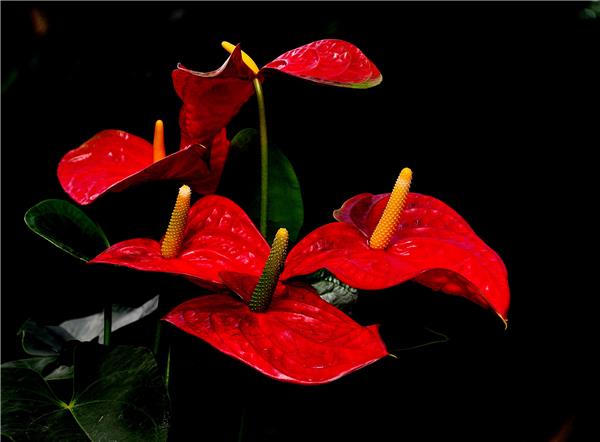
9. What if the leaves of Anthurium andraeanum turn yellow:
There are several main reasons for the yellowing of Anthurium andraeanum leaves: 1 too much watering 2 lack of sunlight 3 lack of fat Anthurium andraeanum leaves, we should pay attention to check the rotten roots, once there are rotten roots to be cut off in time. Excessive watering or excessive light can easily lead to yellow leaves and crimping, so pay attention to adjust the position of potted plants.
Anthurium andraeanum leaves are wide and flowers are large, so you need to wipe the flowers and leaves at the same time when spraying water. Keeping them fresh and clean is the key to plant beauty. Red palm flower is slightly toxic, and the toxin mainly comes from juice. don't eat it by mistake and wash your hands after each care. Anthurium andraeanum had better be cultured outdoors, or in a well-ventilated corner that is not easy to touch.
(1) cut off the withered and diseased leaves in time during the growing period.
(2) when the leaves are too dense, some old leaves should be removed properly. Cutting off old leaves can also promote the growth of new leaves.
7. Points for attention in Anthurium andraeanum culture.
For pot soil, it is better to use 6 parts of rotten leaf soil, 3 parts of river sand (or perlite) and 1 part of organic fertilizer such as rotten cow manure or chicken manure. When it was planted in the pot. The bottom of the basin is filled with soft broken bricks and other materials with a depth of 1 pound, 4 grains and 3 grains, so as to facilitate the drainage of basin soil.
The pots of adult plants were changed once every 2 to 3 years. When changing pots, the old soil was removed and the new culture soil was replaced, and the ramet propagation was carried out. Apply liquid fertilizer every 10 to 15 days during the growing season, keep sufficient water in the basin soil, and often spray water to the leaf surface and the ground around the basin to increase air humidity, but do not spray water on the flowers, so as not to affect the flowering quality. Proper shade should be given in spring and autumn. Light can be seen sooner or later; about 50% or 70% of the sun can be shaded in summer; and no light can be shaded in greenhouse cultivation in winter. It can be placed near the south window in the family.
8. The breeding method of Anthurium andraeanum culture.
Anthurium andraeanum is often propagated by ramets and cuttings.
(1) ramet propagation.
The flowering plants were poured out of the pot from April to May, and the lateral plants with aerial roots were cut off and potted separately to become new plants. The sub-ascending daughter plant should have at least 3-4 leaves.
(2) cuttage propagation.
Cut off the older branches, remove the leaves, make a cuttage for every 1-2 nodes, and insert them upright or horizontally in river sand, vermiculite or perlite. The temperature is kept at 25-35 ℃. Roots and new buds can grow in about 30 days. The seeds of Anthurium andraeanum cultivated in high temperature environment can be obtained by artificial pollination and sown immediately after seed harvesting. The temperature is 25 ~ 30 ℃ and can germinate in about 15 days.
Sowing and reproduction are mainly used in breeding. In recent years, Anthurium andraeanum has been propagated in large numbers by tissue culture.

9. What if the leaves of Anthurium andraeanum turn yellow:
There are several main reasons for the yellowing of Anthurium andraeanum leaves: 1 too much watering 2 lack of sunlight 3 lack of fat Anthurium andraeanum leaves, we should pay attention to check the rotten roots, once there are rotten roots to be cut off in time. Excessive watering or excessive light can easily lead to yellow leaves and crimping, so pay attention to adjust the position of potted plants.
Anthurium andraeanum leaves are wide and flowers are large, so you need to wipe the flowers and leaves at the same time when spraying water. Keeping them fresh and clean is the key to plant beauty. Red palm flower is slightly toxic, and the toxin mainly comes from juice. don't eat it by mistake and wash your hands after each care. Anthurium andraeanum had better be cultured outdoors, or in a well-ventilated corner that is not easy to touch.
Related
- Wuhan Hospital Iron Tree Blooming Result Was Instantly Frightened by the Gardener Master
- Which variety of camellia is the most fragrant and best? Which one do you like best?
- What is the small blue coat, the breeding methods and matters needing attention of the succulent plant
- Dormancy time and maintenance management of succulent plants during dormancy
- Minas succulent how to raise, Minas succulent plant pictures
- What are the varieties of winter succulent plants
- How to raise succulent plants in twelve rolls? let's take a look at some experience of breeding twelve rolls.
- Attention should be paid to water control for succulent plants during dormant period (winter and summer)
- Watering experience of twelve rolls of succulent plants
- Techniques for fertilizing succulent plants. An article will let you know how to fertilize succulent plants.


